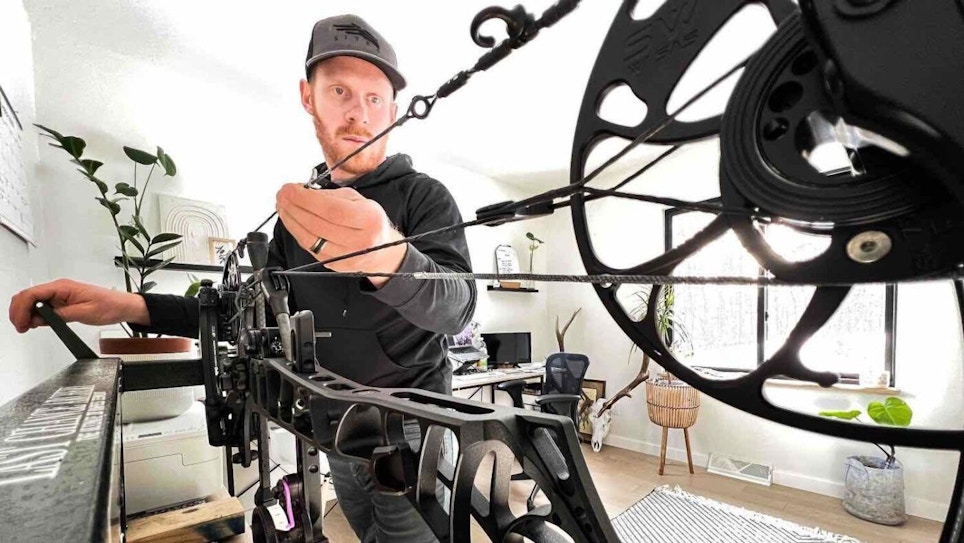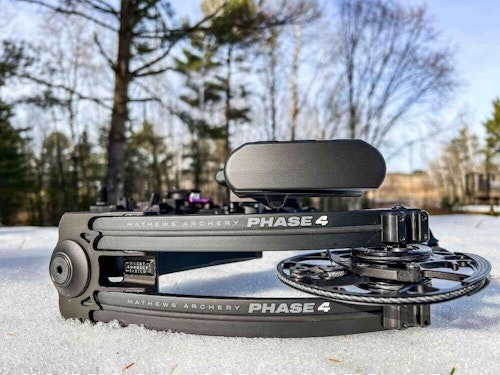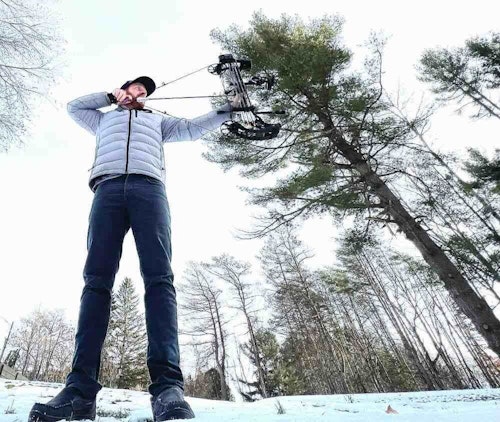
The 2023 Mathews Phase4 strongly resembles last year’s V3X at a glance; the advancements are in the fine details.
In 2020, I shot the Mathews VXR 28 all hunting season. It had been 6 years since I previously hunted with a Mathews. I was fortunate enough to take a gobbler, a bull elk and two bruiser whitetails with perfectly placed shots. It was my “dream season.” I don’t know how else to say it: I felt confident and deadly every time I stepped afield. If someone told me I could hunt with no other bow for the rest of my life, I’d have been fine with that.
But, Mathews doesn’t work that way. The engineers and product development folks see technology advancement as a room without a roof, a ladder with no top step. It has been captivating to watch the progression from the 2020 VXR to the 2023 Phase4. Every technological addition — large or small — rolled out along the way plays a definitive purpose in “elevating the archery experience,” as the company puts it. And now, there are two more.
At a glance, the Phase4 appears uncannily similar to last year’s V3X. In many ways, it is very similar. However, the goods are in the fine details. It’s what you don’t see in a quick glance that makes the Phase4 what Mathews calls its quietest bow yet.
Test Bow Specs
- Axle to Axle Length: 29 inches
- Brace Height: 6 inches
- Draw Length: 28 inches
- Draw Weight: 70.1 pounds
- Let-off: 85%
- Bow-only Weight: 4.48 pounds
- Accessorized Total Weight:
- 6.8 pounds (including arrows in quiver)
- Velocity: 281 fps (with 468-grain Easton 6.5mm Acu-Carbon 340 arrow)
- Kinetic Energy: 82.04 foot-pounds
- Test-Bow Finish: Black (riser),
- Black (limbs)
- MSRP: $1,299 (starting price)
- Contact: www.mathewsinc.com
First Impressions
The 2019 Mathews Vertix premiered a new arrow rest mount called Integrate, which mates the Mathews UltraRest Integrate MX directly to the center of the riser. The mounting system is more secure and solid, and it centers the accessory weight with the riser.
Mathews continued down that road. The 2022 V3X debuted two new accessory mounting locations. Bridge-Lock Technology allows a compatible dovetail sight to slide directly into the riser. This not only positions the sight weight in the center of the riser, but it eliminates the sight bracket, too. Use the Integrate MX rest and a Bridge-Lock Technology-compatible sight, and there’s room for the Mathews LowPro Quiver, which sits closer to the riser than ever before to redefine balance.

The 2023 Phase4 incorporates the same sight, quiver and arrow rest mounting mediums as last year’s V3X, but now the stabilizer was addressed, too. There’s still a conventional stabilizer-mounting hole, but beneath it is a slot through the riser that accommodates Mathews’ new Bridge-Lock Stabilizer. This genius combination is an advancement like we haven’t seen in stabilizers before. The stabilizer bar mates directly with the riser, which stiffens the connection and reduces felt vibrations, and it can adjust in half-inch increments in order to achieve a custom, individualized feel and balance.
Bridge-Lock Stabilizers are available 8, 10 and 12 inches. The end of the bar is weighted and designed to thwart vibrations with the Harmonic Stabilizer Nano EHS. Additional 1-ounce stackable weights ($19.99 MSRP each) provide an even greater level of balance customization with a new stacking system.
Now that Mathews has addressed every accessory mounting location and design, pairing the Phase4 with integrating accessories makes them virtually part of the bow rather than mere tack-ons. Everything is more aesthetically pleasing and certainly more solid and dependable. And, the balance is nothing short of superior.
Stealth Redefined
If you know anything about bows, it’s a given that split-limb bows traditionally have two limbs on top and two on bottom. If you look at the Phase4’s limbs, they look similar to other split limbs, but with rubber veins on the top and bottom of each limb. However, those rubber veins aren’t cheap stick-ons. No, the Phase4 actually has eight separate limbs, and the dampening rubber is sandwiched between every limb pair.
Mathews calls this technology Resistance Phase Damping. It might initially seem that more parts mean more variables, but Mathews completed extensive testing in both extreme hot and cold temperatures with no negative impacts on accuracy or consistency.

Limbs store energy at full draw, and limb movement at the shot generates vibrations — that’s common knowledge. From there, the vibrations transfer to the riser and eventually the shooter’s hand. Because Mathews addressed vibrations at their source (the limbs), the felt vibration in the Phase4’s riser and at the grip is nothing. Resistance Phase Damping and the direct-mount Bridge-Lock Stabilizer really clean up noise and vibrations. The Phase4 is tested to be up to 13 percent quieter with up to 37 percent fewer vibrations than past models.
On the Range
Not surprisingly, the Phase4 aimed effortlessly as I zapped my backyard targets from 10 to 60 yards in Wisconsin’s northern chill. A large contributor is the optimal accessorized balance, but let’s not overlook something Mathews has been doing very well for years, which is incorporating an incredibly long riser with short, parallel limbs. The long Bridge-Lock Riser delivers target-like stability in an ultra-maneuverable 29-inch hunting platform.
Years ago, I favored longer lengths in the 34- to 36-inch range for the added stability, but there’s no need because the 29 delivers the stability of a much longer bow. For customers who demand even more stability, the Phase4 is also available in a 33-inch version. As always, the bridged riser design is super-rigid, which addresses flexing as the bow is drawn and shot, improving shot-to-shot consistency and simplifying tuning.
Accuracy? No problem for the Phase4. I moved my Spot-Hogg Fast Eddie XL bowsight over from the V3X, and in two shots, I hit the 12-ring at 20 yards. My other pins out to 60 yards were all spot on, and shooting at 60 yards in the cold was a piece of cake for me. I even shot Helix fixed-blade broadheads out to 40 yards with pinpoint accuracy.
I can’t say that I love the standard Mathews grip, but I did this test with it, and accuracy didn’t compromise. Still, I’ll go with the Mathews Engage Side Plates — much more comfortable for me — before I hunt with the Phase4. I favor hand-on-riser gripping for better consistency, particularly while wearing thin gloves in hunting situations.
Final Thoughts
I appreciate the purposeful little details that Mathews has carried over such as the S.A.S. (Stay Afield System), which lets hunters service their bowstring and cables in the field without a bow press. Also, the Silent Connect System introduced on the VXR continues to be a win for carrying the Phase4 with the Silent Connect Sling, hoisting the bow up to a treestand using the Silent Connect Bow Rope, or attaching the Defender Series String Protector.
The Crosscentric Cam with SwitchWeight Technology is the pinnacle — at least for now — of smoothness and shootable speed. In the past, I’ve typically shot 70 pounds, but I always go with 75 now for my personal Mathews hunting bow because the Crosscentric draws so smoothly. For tuning, the Top Hats also carried over. There are simpler designs on the market for pushing the cam left or right without a bow press, but to Mathews’ credit, the Tops Hats require no extra bolts or parts. Plus, they work.
Finally, there was no need to get settled in with the Phase4. I felt like I was shooting my V3X, but experiencing a smoother, quieter shot. Mathews aims to beat their previous flagship with every new bow they launch. Have they done it? Yes, they have.
Editor's note: Click here to watch the author's in-depth review video for the new Mathews Phase4 29.
Additional Notes
The Phase4 was set up using a Last Chance Archery EZ Green Bow Press and EZ Green Bow Vise, and draw weight was calculated using Last Chance Archery’s Digital Bow Scale. A Caldwell Ballistic Precision Chronograph measured the 468-grain Easton 6.5mm Acu-Carbon 340 arrow’s velocity. Easton’s Nock and D-Loop Pliers and Pro Hex Fold-Up Allen Set.
In-the-field photos by Becca and Darron McDougal








